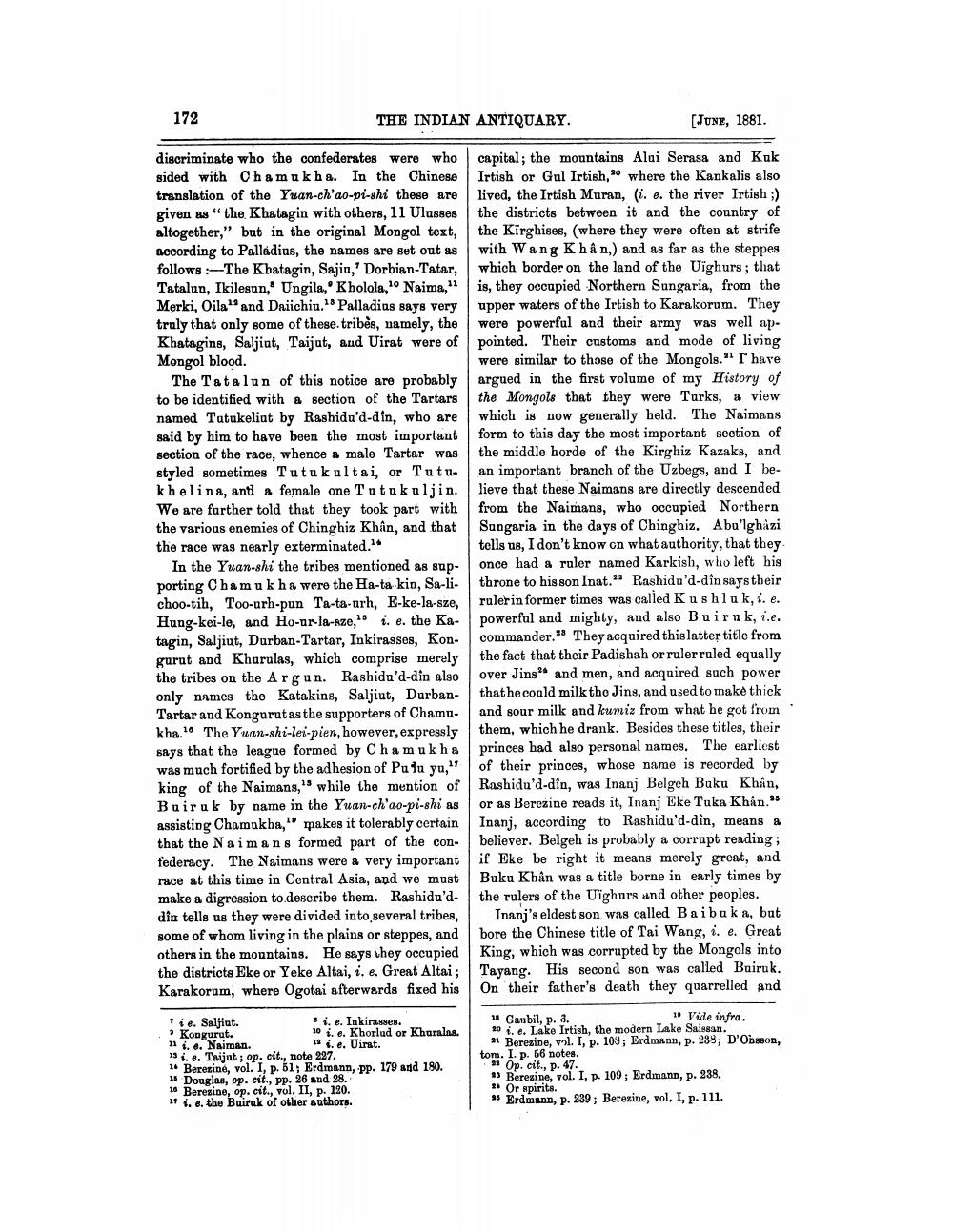________________
172
THE INDIAN ANTIQUARY.
[JUNE, 1881.
discriminate who the confederates were who sided with Chamukha. In the Chinese translation of the Yuan-ch'ao-pi-shi these are given as "the Khatagin with others, 11 Ulusses altogether," but in the original Mongol text, according to Palladius, the names are set out as follows :-The Kbatagin, Sajia,' Dorbian-Tatar, Tatalun, Ikilesun, Ungila, Kholola, Naima," Merki, Oila" and Daiichiu." Palladius says very truly that only some of these tribes, namely, the Khataging, Saljint, Taijat, aud Virat were of Mongol blood.
The Tatalun of this notice are probably to be identified with & section of the Tartars named Tutukeliat by Rashidu'd-dîn, who are said by him to have been the most important section of the race, whence & male Tartar was styled sometimes Tutukultai, or Tutukhelina, anti a female one Tutukuljin. We are farther told that they took part with the various enemies of Chinghiz Khân, and that the race was nearly exterminated."
In the Yuan-shi the tribes mentioned as supporting Chamukha were the Ha-ta-kin, Sa-lichoo-tih, Too-urh-pun Ta-ta-urh, E-ke-la-sze, Hung-kei-le, and Ho-ar-la-eze, . e. the Katagin, Saljiut, Durban-Tartar, Inkirasses, Kongurut and Khurulas, which comprise merely the tribes on the Argun. Rashidn'd-din also only names the Katakins, Saljiut, DurbanTartar and Kongurut as the supporters of Chamukha. The Yuan-shi-lei-pien, however, expressly says that the league formed by Chamukha was much fortified by the adhesion of Pulu yu," king of the Naimans," while the mention of Buiruk by name in the Yuan-ch'ao-pi-shi as assisting Chamukha,'' makes it tolerably certain that the Naimans formed part of the confederacy. The Naimans were a very important race at this time in Central Asia, and we must make a digression to describe them. Rashidu'd. din tells us they were divided into several tribes, some of whom living in the plains or steppes, and others in the mountains. He says they occupied the districts Eke or Yeke Altai, i. e. Great Altai; Karakorum, where Ogotai afterwards fixed his
capital; the mountains Alui Serasa and Kuk Irtish or Gul Irtish," where the Kankalis also lived, the Irtish Muran, i.e. the river Irtish ;) the districts between it and the country of the Kirghises, (where they were often at strife with Wang Khân,) and as far as the steppes which border on the land of the Uighurs; that is, they occupied Northern Sungaria, from the upper waters of the Irtish to Karakorum. They were powerful and their army was well appointed. Their customs and mode of living were similar to those of the Mongols." I have argued in the first volume of my History of the Mongols that they were Tarks, a view which is now generally held. The Naimans form to this day the most important section of the middle horde of the Kirghiz Kazaks, and an important branch of the Uzbegs, and I believe that these Naimans are directly descended from the Naimans, who occupied Northern Sungaria in the days of Chinghiz. Abu'lghazi tells us, I don't know on what authority, that they once had a ruler named Karkish, who left his throne to his son Inat." Rashidu'd-dîn says their rulerin former times was called Kushluk, i.e. powerful and mighty, and also Buiruk, i.e. commander.28 They acquired thislatter title from the fact that their Padishah or rulerruled equally over Jins" and men, and acquired such power that he could milk the Jins, and used to make thick and sour milk and lumiz from what he got from them, which he drank. Besides these titles, their princes had also personal names. The earliest of their princes, whose name is recorded by Rashidu'd-din, was Inanj Belgeh Buku Khan, or as Berezine reads it, Inanj Eke Tuka Khân.'' Inanj, according to Rashidu'd-din, means a believer. Belgeh is probably a corrupt reading ; if Eke be right it means merely great, and Buku Khân was a title borne in early times by the rulers of the Uighurs and other peoples.
Inanj's eldest son was called Baibuka, bat bore the Chinese title of Tai Wang, i. e. Great King, which was corrupted by the Mongols into Tayang. His second son was called Buiruk. On their father's death they quarrelled and
Tie. Saljint.
• i.e. Inkirasses. Kongurut.
20 i. e. Khorlad or Khoralns. 11. 6. Naiman.
1 .e. Uirst. 13 1. e. Taijat; op. cit., note 227. 1. Berezine, vol. I, p. 51; Erdmann, pp. 179 and 180. · Douglas, op. cit., pp. 26 and 28. 16 Berezine, op. cit., vol. II, p. 120. 11 6. e. the Buiruk of other authors.
15 Ganbil, p. 8.
10 Vide infra. to 1. e. lake Irtish, the modern Lake Saissan.
u Berezine, vol. I, p. 109; Erdmann, p. 239; D'Obsson, tom. I. p. 56 notes.
* Op. cit., p. 47. * Berexine, vol. I, p. 109; Erdmann, p. 238. 3. Or spirits.
Erdmann, p. 239; Berezine, vol. I, p. 111.




